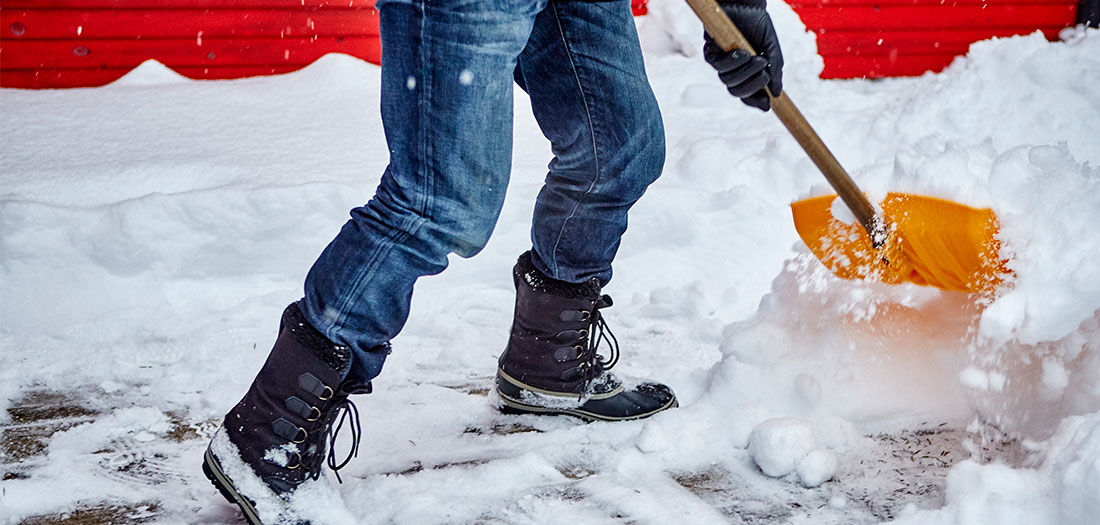This time of year signals the advent of cold weather in many areas of the country. During a typical winter, it is not uncommon to hear about cardiac-related deaths linked to physical exertion—namely snow shoveling. What is it about the combination of cold weather and physical exertion that places a person at risk for a cardiac event—especially older, unfit individuals or those with cardiac disease?
Cold temperatures cause blood vessels throughout the body to temporarily constrict (i.e., vasoconstriction), raising blood pressure. Blood flow to the heart is reduced as a result of the narrowing of the coronary arteries caused by the vasoconstriction. This reduction in blood flow to the heart, combined with the increased oxygen demand by the heart due to the physical exertion, can cause an imbalance between myocardial oxygen supply and demand. When such an imbalance occurs, coronary insufficiency leads to cardiac symptoms and potentially a heart attack if the imbalance is severe enough.
Exercising in cold weather generally isn’t a problem for young and active individuals. The risk, however, significantly increases as a person reaches middle age and beyond. The risk has been observed to be highest for adults who are ages 65 and older, particularly those with underlying medical conditions (e.g., diabetes, obesity, hypertension or preexisting heart disease). For individuals with one of these conditions, spending just a few minutes in extremely cold temperatures can trigger a substantial increase in blood pressure.
For this reason, many cardiologists encourage their older or deconditioned patients to opt for indoor physical activity on cold winter days.
If an individual at risk for, or with known, cardiovascular disease chooses to brave the cold to perform his or her physical activity, here are a few practical tips for helping to ensure it’s a reasonably safe experience.
Check the weather forecast.
Check the air temperature and wind-chill factor before exercising in the cold. Health risks increase when the combined temperature and wind chill falls below -20° F (-29° C).
Bundle in layers.
Wear several layers of clothing so that articles can be removed—a layer at a time—as you become warmer while exercising. It will help you guard against overheating, sweating and, eventually, becoming colder.
Wear bright and/or reflective clothing.
It gets darker sooner during the winter months, so be sure you’re clearly visible to motorists.
Cover your head.
Always wear a hat, as you lose significant (up to 20%) of your body heat from your uncovered head. Note: Old estimates of 50% heat loss via an uncovered head have been observed to be bit exaggerated.
Wear shoes with good traction.
Good footwear will help prevent slips and falls on snow or ice and ensure reasonably stable footing.
Drink plenty of fluids.
Staying properly hydrated is just as important during cold-weather exercise as it is during hot-weather exercise. Drink before, during and after your workout, even if you don't feel very thirsty, as dehydration may be more difficult to notice during cold-weather exertion.
Extend your warm-up and cool-down.
Make sure you warm up before you start your activity. Your warm-up should last at least 10–15 minutes, and you should also cool down for at least 10–15 minutes at the end.
Start low and progress slowly.
Gradually increase your level of activity, in terms of both the intensity of the activity and the amount of time you spend doing it. This approach helps to ensure that your body (especially the cardiovascular system) has adequate time to adapt to the stress of the exertion.
Mom was right: Let your food digest.
Avoid exercising after a large meal, since blood flow will be diverted from other areas of the body to aid digestion.
Report any changes to your doctor.
Don’t start any new activity without discussing it first with your doctor. Also, report any symptoms (if any) that you experience when exercising in the cold.
Know when to say no.
Don’t exercise if you have a viral infection (for example, a sore throat) or a high temperature.
Have someone by on standby.
Tell someone what route you're taking and when to expect your return, just in case something unexpected happens.
Know when to stop.
Head indoors right away if your chest starts hurting, you feel lightheaded or short of breath, your heart starts racing, or if you experience some other physical change that makes you nervous. If you think you are having a heart attack, call 911 or your local emergency number.
Be prepared for an emergency.
If your doctor has prescribed glyceryl trinitrate (GTN) spray or tablets, be sure to take them with you. If you have coronary heart disease and are taking GTN spray or tablets for your angina symptoms and you experience chest pain or discomfort when exercising, take the following actions:
- Stop what you are doing, sit down and rest.
- Use your GTN spray or tablets. Take the GTN as your healthcare provider has instructed. The pain should ease after a few minutes. If it doesn’t, take your GTN again.
- If the pain does not ease within a few minutes of taking the GTN the second time, call 911 or your local emergency number.
- If you’re not allergic to aspirin, chew an adult aspirin tablet (300 mg) if there is one readily available. If not, just continue resting until the ambulance arrives.
Ultimately, the key to safely exercising outdoors during the winter months is to be smart and prepared. Bundle up—in layers. Use common sense with regard to your level of physical exertion. Unless the wind-chill index or your healthcare provider dictate otherwise, don’t let the elements rob you of the joys and benefits of exercising outside.

Cardiac Risk Associated with Shoveling Snow
Why is snow shoveling so dangerous for many people? Snow shoveling creates a “perfect storm” of demands on the heart. With snow shoveling, the real danger—particularly for those who are older and/or sedentary—is the physical exertion.
Shoveling snow is strenuous work. It involves isometric exercise and unaccustomed muscle tension, which increases heart rate and blood pressure. Your legs may stay “planted” when you shovel, which encourages blood to pool in the legs and reduces circulation to the heart, creating an imbalance between myocardial oxygen demand and supply. To make matters worse, people tend to hold their breath (this is known as a Valsalva maneuver, and it often occurs when people are straining to lift heavy loads) when they are repeatedly heaving shovel loads that typically weigh 10–15 pounds (including the weight of the shovel), which causes a further rise in heart rate and blood pressure. That’s why every winter we read or hear about people who experience a fatal heart attack while shoveling snow.
Is there any way to reduce the risk associated with snow shoveling? If you’re a person with known or suspected heart disease, it may be advisable that you don’t shovel your own snow. Instead, hire a neighborhood youth or someone else to do it for you. If you’re presumably healthy and in relatively good shape, take the following precautions when shoveling your own snow:
Shovel in the afternoon.
In general, most heart attacks occur in the morning between 6:00 and 10:00 am, when heart rate and blood pressure tend to be higher. You’re also more likely to form blood clots during the morning hours.
Pace yourself.
Be sure to shovel slowly. Work for only a few minutes at a time and keep your legs moving to circulate blood.
Push rather than lift.
If possible, push the snow rather than lifting it. This helps keep your legs moving and takes less exertion than lifting. There are snow shovels designed for pushing snow.
Learn more about exercise and heart health here.




 by
by 







 by
by